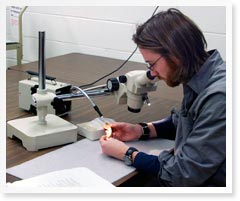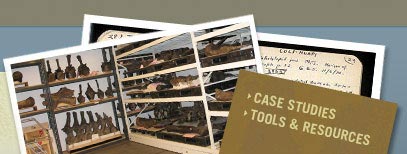Visitation and Access
Promoting reasonable access to and use of its collections is a key part of a museum’s mission. But museums also have to determine what constitutes access, as it comes in several forms. At the same time, museums have a responsibility to protect their collections from misuse, damage, or theft and to ensure that access for museum research and education programs is not impeded. Collection access and security procedures have to minimize conflict between these two complementary objectives.
What constitutes access?
Granting access does not necessarily mean giving researchers and the wider public free reign in collection areas. It may involve providing on-line access, by digitizing collection archives and specimen images, or by creating collection databases. Creating exhibits that draw on the collections is another form of access, as is the publication of information about specimens in popular articles or scientific journals.
Even when physical access is granted, the level of access and the degree of supervision will vary according to the type of visitor, their particular needs, and the resources available to the institution.
Visitation

Regardless of whether you are a staff member or a visitor, access to collections is a privilege, not a right. When you are given access, you have to take on some of the responsibility of ensuring the security of the building and its collections. It is important to make this clear to all visitors and to emphasize that failure to fulfill this obligation may result in restriction or loss of access.
Decisions must be made on whether researchers will be allowed into collections storage areas, at what level their contact with collections will be supervised, or whether requested specimens will be brought to a supervised workroom location. These decisions are going to be dependent on a variety of factors, including the visitor’s familiarity with the collection; their experience in safely handling fossil material; the layout of the collection space; and the number, size, and location of the specimens. Unless the visitor is well known to you, granting of access should always be subject to appropriate references from their home institution, major graduate advisor, etc.
Security
Security Tips
Applications by scholars to visit collections should be made in writing via a letter with an institutional letterhead.
Students should additionally be asked to provide a letter of reference from their graduate or undergraduate advisor, which should also be on institutional letterhead.
Due to the unfortunate, if unusual occurrence, of visitors falsely claiming institutional affiliations or status in order to gain access to the collections, the status of first-time visitors should always be double-checked.
Appropriate security is an issue for both institutional and personal collections. The goal is to deter planned as well as opportunistic theft, or vandalism. At the most simple level, access to specimens should be restricted by keeping them in lockable cabinets, or by keeping collection rooms looked. In larger institutions, where you may not know all the staff by sight, or where there may be large numbers of visitors, it’s a good idea to require employees and authorized visitors to wear visible identification.
Developing good check-in procedures can also reduce security risks. Having visitors sign in and out of the collection helps keep track of who is working in the collection. Requiring visitors to leave bags, coats, etc. in an office or locker can reduce the opportunity for unauthorized removal of specimens. Finally, maintaining written records of each visit and the specimens examined can help in tracing missing or damaged specimens, while providing important statistics to demonstrate use of the collection to granting agencies and administration. You can view the American Museum of Natural History’s Visitor Arrival form (pdf) and Visitor Guidelines (pdf) as well as checking the website to learn more on how to visit the departmental collections and archives.
Links
- The Museum, Library, and Cultural Properties Council of ASIS International and the Museum Association Security Committee of AAM share Suggested Practices for Museum Security. The document addresses fire protection, burglar alarms, key control, access control, security staffing & training, security officer qualifications, and pre-employment screening for museum employees.
- The Museums, Libraries and Archives Council (UK) offers Security in Museums, Archives and Libraries: A Practical Guide with extensive useful information.
- Collections Link is a website with extensive practical advice in short fact sheets on security and access as well as a wealth of other topics.
- The Northeast Document Conservation Center’s Technical Preservation Leaflet 3.11 is on Collections Security: Planning and Prevention for Libraries & Archives.



